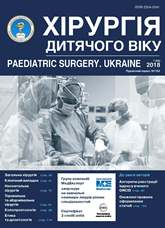Urgent treatment of amniotic bands in a newborn
DOI:
https://doi.org/10.15574/PS.2018.58.52Keywords:
amniotic bands, newborns, surgical treatmentAbstract
Amniotic band sequence is a congenital anomaly. The incidence of the disease ranges from 1:1,200 to 1:15,000 of live births. There are several theories of the origin of amniotic band sequence. The treatment of amniotic bands is only surgical, which is elective and performed most often after one year of age. The clinical case of successful urgent treatment of amniotic band is represented in the article. It is shown that in the face of a limb necrosis, the surgical treatment must be carried out urgently.References
Kozlova SI, Demikova NS i dr. (1987). Nasledstvennyie sindromyi i mediko-geneticheskoe konsultirovanie. Leningrad: Meditsina: 28–29.
Romero R, Pilu Dzh i dr. (1974). Prenatalnaya diagnostika vrozhdennyih porokov razvitiya ploda. Moskva: Meditsina: 412–414.
Garza A, Cordero JF, Mulinare J. (1988). Epidemiology of the early amnion rupture spectrum of defects. Am J Dis Child. 142: 541–544. https://doi.org/10.1001/archpedi.1988.02150050079037
Jones KL. (1981). Smith’s recognizable patterns of human malformations. California: W.B. Sauders Company: 636–639.
Srinivasan H, Dhungel P, Harper T, Lampley C. (2014). Amniotic Band Syndrome: A Case Series. J Preg Child Health 1: 109. doi 10.4172/2376- 127X.1000109
Torpin R. (1965). Amniochorionic mesoblastic fibrous strings and amnionic bands: Associated constricting fetal malformations or fetal death. Am J Obstet Gynecol. 91: 65–75. https://doi.org/10.1016/0002-9378(65)90588-0
Downloads
Issue
Section
License
The policy of the Journal “PAEDIATRIC SURGERY. UKRAINE” is compatible with the vast majority of funders' of open access and self-archiving policies. The journal provides immediate open access route being convinced that everyone – not only scientists - can benefit from research results, and publishes articles exclusively under open access distribution, with a Creative Commons Attribution-Noncommercial 4.0 international license(СС BY-NC).
Authors transfer the copyright to the Journal “PAEDIATRIC SURGERY.UKRAINE” when the manuscript is accepted for publication. Authors declare that this manuscript has not been published nor is under simultaneous consideration for publication elsewhere. After publication, the articles become freely available on-line to the public.
Readers have the right to use, distribute, and reproduce articles in any medium, provided the articles and the journal are properly cited.
The use of published materials for commercial purposes is strongly prohibited.

